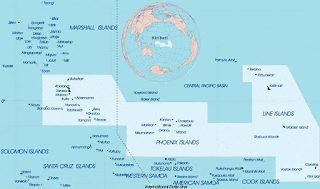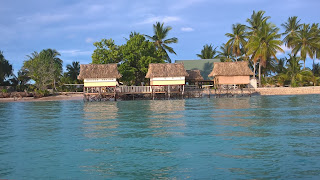Kiribati 101
Introduction
Kiribati (pronounced, Ki-ri-bus) is a smattering of small coral atolls
scattered across an area of ocean the size of the continental United States and
is one of the poorest, and least visited countries, in the world. With a
maximum elevation of 3 metres above sea level the tiny atolls are very susceptible
to sea level rise and indeed some communities have had to be abandoned in recent
years.
South Tarawa
North Tarawa is much more sparsely populated and consists of a string of islets,
with the most northern islet being Buariki. The islets are separated in places
by wide channels that can be crossed at low tide. On South Tarawa, the
construction of causeways has now created a single strip of land from Betio in
the West to Buota in the Northeast and it is on this narrow strip of land that
the bulk of the population live.
Tarawa has a large lagoon of approximately 500 square kilometres (193 square miles) and a wide reef. Although naturally abundant in fish and shellfish of all kinds, marine resources are being strained by the large, and growing, population and it is not recommended that people swim in it due to the amount of raw sewage that it contains. Drought is frequent in Kiribari but in normal years rainfall is sufficient to maintain breadfruit, papaya and banana trees as well as coconut and pandanus.
Kiribati has few natural resources and is one of the least developed
Pacific Island countries. Economic development is constrained by a shortage of
skilled workers, weak infrastructure, and remoteness from international
markets. The public sector dominates economic activity, with ongoing capital
projects in infrastructure including road rehabilitation, water and sanitation
projects, and renovations to the international airport, spurring some growth.
South Tarawa is the economic hub of Kiribati, the location of the main
port and airport and of most of the State Owned Enterprises and private
businesses. Copra produced on the outer islands is processed on Betio,
producing copra oil for the international market and other products which are
sold locally. There is also a fish processing plant producing tuna for export.
However, imports far outweigh exports, and most households on South Tarawa rely
on Government employment and remittances from relatives working overseas for
their income.
Employment
Unemployment and under-employment are a serious problem; in 2010 only 34% of urban adults (over 15) were engaged in cash work; the remaining two-thirds are either out of the labour force, unemployed or engaged in subsistence activities. Young people are especially likely to be unemployed and this is a growing problem. According to the ILO the unemployment rate for Kiribati in 2010 was 30.6% (27.6% for males , 34.1% for females) while youth unemployment
rate was 54% (47.6% for males, 61.8% for females). In 2017 Kiribati is ranked
17th in the world in terms of percentage of the population that are unemployed
(https://photius.com/rankings/2017/economy/unemployment_rate_2017_0.html)
Of these
with jobs over two thirds are in the public sector so it has a very small private sector.
Tourism
Kiribati is well of the usual beaten track for most tourists. Kiribati is one of the least visited
countries in the world. In 2016 it had 4,000 tourist visits It is definitely not Fiji or Rarotonga when it comes to tourism numbers or
amenities available. There are some basic accommodation for tourists but you won’t find
any 5 star resorts here. Being off the beaten track it is a destination for
intrepid travellers not tourists, which for me is part of its attraction.
Environmental Issues
Kiribati is experiencing first hand the impact of climate change and,
even more so than some of its volcanic neighbours, is the canary in the mine
when it comes to warning us of the impact that climate change will have, and
is, having on the planet. It is facing problems resulting from both sea level
rise and rapid population growth (it has the fastest growing population in the
Pacific). Some settlements have been abandoned due to frequent flooding and
fresh food, especially fruit and vegetables, are often in short supply due to
the salination of the soils, meaning a lot of food needs to be imported. So
Kiribati is not your typical South Pacific paradise. In fact the country has
purchased land in Fiji for when, not if, the people are forced to leave their
homeland for good!
Why the interest in Kiribati/Tarawa?
So why the sudden interest in Tarawa and Kiribati? Well, as alluded to in the previous post, apart from my general interest in World War Two history, it is because I’m off to live there for a year! I’ve accepted a role with New Zealand’s Volunteer Service Abroad and will be living there for twelve months. It is not going to be easy, no doubt there will be many, many challenges and struggles ahead but I am hoping that the experience will be a life changing one. I've never been a fan of the corporate treadmill so see this as an opportunity to branch out and do something completely outside my comfort zone. I’ve been wanting to do a VSA assignment for many years but it is only now that my kids are nearing the end of high school that I feel the time is right. So recently I applied for a role in Kiribati and am pleased to say that I have been accepted for the one year posting as and English Language trainer at the Marine Training Centre on Betio in South Tarawa.
So why the sudden interest in Tarawa and Kiribati? Well, as alluded to in the previous post, apart from my general interest in World War Two history, it is because I’m off to live there for a year! I’ve accepted a role with New Zealand’s Volunteer Service Abroad and will be living there for twelve months. It is not going to be easy, no doubt there will be many, many challenges and struggles ahead but I am hoping that the experience will be a life changing one. I've never been a fan of the corporate treadmill so see this as an opportunity to branch out and do something completely outside my comfort zone. I’ve been wanting to do a VSA assignment for many years but it is only now that my kids are nearing the end of high school that I feel the time is right. So recently I applied for a role in Kiribati and am pleased to say that I have been accepted for the one year posting as and English Language trainer at the Marine Training Centre on Betio in South Tarawa.
I’ll be leaving my wife and kids back home in NZ but due to the isolated
nature of Kiribati volunteers have to leave the island every 4 months or so for
a week or two break either back home or elsewhere in the Pacific so plan on
meeting up with my wife in Fiji every four months or so and hope that other
family members will take the opportunity to pop out for a visit to one of the
more remote corners of the Pacific.
No doubt the year ahead will be fraught with challenges and it will be a
very difficult one, but I am really looking forward to the experience, it is
something I’ve been wanting to do for a long, long time.
Recently Stuff.co.nz did an article on Kiribati
which can be found here: The Angry Sea Will Kill Us. However, the “kingtide” referred to in the article was actually caused by wave swells
resulting from Cyclone Pam which had devastated
Vanuatu.
National Geographic has an interesting article on the impact of climate change on Kiribati here.
National Geographic has an interesting article on the impact of climate change on Kiribati here.
Craig









Comments
Post a Comment